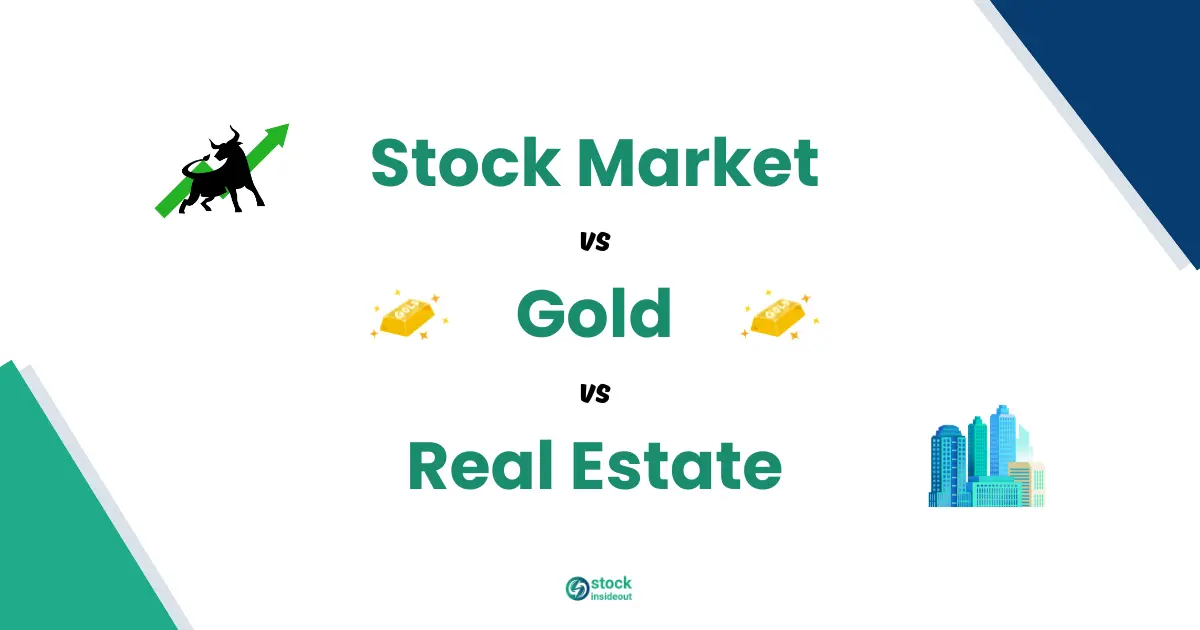If you had invested Rs. 1 lakh in 2005, how much would it have been today? The answer actually depends a lot on whether you invested in stock market, gold, or real estate. Every investment comes with its own perks and risks, but most investors chase only one thing: profits. But is investing only about profits? or also about living happily with what your investment brings to your life? Let’s dive in and find out.

Historical Returns Stock Market vs Real Estate vs Gold
Since returns are what everyone looks for, let us take a look at how these investments have returned over the 2 decades.
| Asset | Avg Annual Return (20 Years) | ₹1L, 20Y Later |
|---|---|---|
| Stock Market | 15%-16% | 16-18 Lakh |
| Real Estate (Mumbai) | 10%-11% | 6-8 Lakh |
| Gold | 12% | 9.6 Lakh |
Note: The values are approximate.
Historically, the Indian stock market has outperformed gold and real estate by some margin in the last two decades. Over the past 20 years, Nifty 50 (India’s benchmark index) delivered 15%-16% returns annually. While Mumbai’s real estate has seen growth at 10%-11% every year.
Meanwhile, one of the safest considered investment tools, gold, has been growing steadily at around 12% annually for the last 20 years.
Risk Involved
Stock Market
There goes a saying, ‘The higher the risk, the higher the reward,’ and the stock market fits perfectly with this saying. While it may deliver high returns, it also comes with high risk. The high risk because of the price fluctuations over the period, sharp falls, and high volatility makes it a riskier investment compared to other investment tools like gold and real estate, which move slower but steadily.
Real Estate
‘Jameen le lo, rate to badhega hi.’ This is a common belief among Indians when it comes to real estate. And they’re not entirely wrong. Mumbai’s real estate has grown steadily over the years and is often seen as a safe investment for wealth preservation. But like any investment, real estate comes with risks too. The most common risks include:
- Poor locality (such as fewer schools and hospitals, bad environment, less connectivity, less development).
- Crime and safety issues in the locality.
- High possibilities of frauds.
- Low liquidity (hard to sell quickly).
While these risks are likely to have low chances, they can hamper the investment growth over the years.
Gold
Gold is often seen as the safest option among the three. It has performed well during times of inflation or economic crises. However, it also comes with some risk since it is dependent heavily on global factors such as inflation and interest rates.
Affordability and Possibilities
When it comes to affordability, stock market investments are the easiest to start with. Even Rs. 100 can be invested in equities or mutual funds, making it highly accessible to almost everyone.
Real estate, on the other hand, requires a high amount of capital to invest. Buying property in Mumbai or any other metro city needs lakhs or even crores, often with additional costs like registration and taxes. While it moves steadily, the high amount of requirements makes it unaffordable for the investors.
Gold sits in the middle. Investors can start with very small amounts through digital gold or gold ETFs, making it more affordable than real estate. Over the years, gold has moved consistently, giving returns close to real estate but with easy accessibility.
Investments Beyond Returns: Real Life Utility
Investments are done to make profits. However, is that the only goal of investing? Not really. There are many things beyond returns that are provided by certain investments. Unlike the stock market, gold and real estate can also be utilised in daily life while their value grows over time. Here are some unique features of gold and real estate that make them useful beyond just being investments.
- Gold is often valued not just as an investment but also as jewellery, making it culturally significant in India. Physical gold can be worn at functions and weddings, and it can even be gifted on special occasions.
- Gold can provide financial flexibility in case of an emergency by taking a loan against it as security, or it can also be sold anytime, unlike the other two investments.
- Meanwhile, the real estate can be used to gain monthly rental income other than just providing the roof.
- Gold and real estate can be used to hedge against the inflation.
By this we can understand that investing does not only mean just profits; it’s also about how the investment is helping to make life better.
Diversification Matters
Since each investment has its pros and cons, no single option can serve all purposes. That’s where diversification comes in to balance the risk-reward ratio. Here are some points that can be used for different purposes.
- Gold will help to hedge against inflation.
- Real estate not only grows in value but also gives you the comfort of having your own roof and potential rental income.
- Stocks are riskier, but even a small allocation can deliver strong growth over the long term.
- This way, each asset plays a different role of stability, security, and growth. It ensures that even if one asset underperforms, the others can help to keep your investment steady.
Pros and Cons
| Asset | Pros | Cons |
|---|---|---|
| Stock Market |
|
|
| Real Estate |
|
|
| Gold |
|
|
Final Words
In today’s world, investing is a necessity. Whether it is in stock market, real estate or gold, all the investments are done to make profits. However, each one of the asset comes with different risks and rewards. The question is not about which investment is the best, but it about how you strategically you put investments to reach your goal and to keep yourself secure when the time comes.